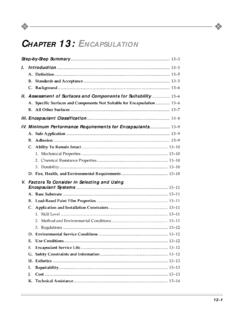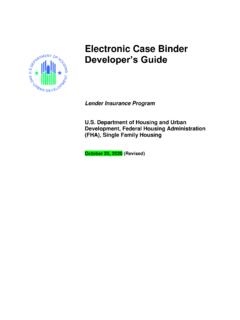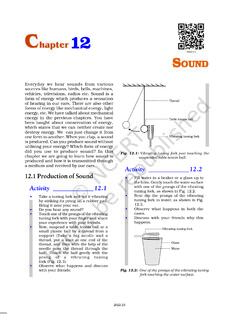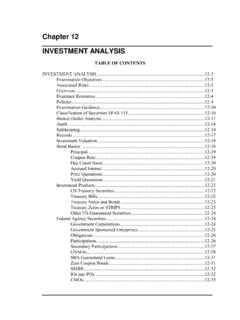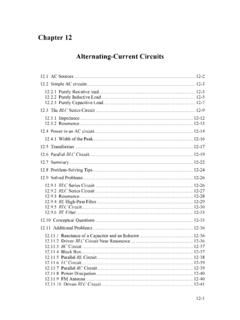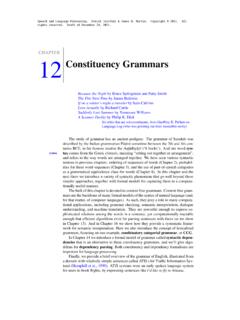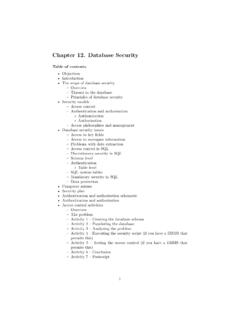Transcription of CHAPTER 12: ABATEMENT - United States Department of ...
1 12 1 CHAPTER 12: AbatementCHAPTER 12: ABATEMENTStep-by-Step Summary for 5I. Principles of Lead-Based Paint Hazard 12 of 12 7B. Prohibited ABATEMENT 12 9C. Periodic Monitoring and 12 91. Recordkeeping .. 12 9D. Types of 12 10E. 12 10F. Relationship to Renovation, Repainting, Remodeling, Rehabilitation,Weatherization, and Other Construction 12 10 Step-by-Step Summary for Building Component 12 13II. Building Component 12 15A. Worksite 12 151. Security .. 12 152. Waste Storage .. 12 15B. General Procedures for Building Component 12 15C. Removal and Replacement Procedures for Specific 12 171.
2 Baseboards, Casings, and Other Trim .. 12 172. Windows .. 12 173. Interior and Exterior Doors .. 12 184. Kitchen and Bathroom Cabinets .. 12 195. Railings .. 12 196. Exterior Siding .. 12 197. Interior Walls .. 12 20D. Transportation and Storage of 12 20 Step-by-Step Summary for Enclosure 12 21 III. Enclosure 12 23A. 12 23B. Longevity of 12 231. Labeling of Enclosed Surfaces .. 12 232. Monitoring Enclosure Integrity .. 12 233. Unsound Substrates .. 12 2412 2 CHAPTER 12: AbatementC. Interior Surface Enclosure 12 261. Wood Paneling .. 12 262. Laminated Products .. 12 263. Ridged Tile and Brick Veneers.
3 12 264. Drywall and Fiberboard .. 12 26D. Interior Building Components Suitable for 12 271. Wood Trim and Drywall .. 12 272. Electrical Outlets and Vents .. 12 283. Ceilings .. 12 294. Floors .. 12 295. Stairs .. 12 306. Pipes .. 12 307. Door Frames .. 12 308. Plywood Enclosures .. 12 30E. Exterior Enclosure 12 301. Siding .. 12 302. Windows .. 12 313. Exterior Walls .. 12 32F. 12 32 Step-by-Step Summary for Paint Removal 12 33IV. Paint Removal 12 35A. 12 35B. Prohibited 12 351. Open Flame Burning or Torching .. 12 352. Machine Sanding or Grinding Without a HEPA Exhaust Tool.
4 12 353. Uncontained Hydroblasting or High-Pressure Water Wash .. 12 364. Abrasive Blasting or Sandblasting .. 12 36C. Methods Not 12 371. Dry Scraping .. 12 372. Chemical Paint Removers Containing Methylene 12 37D. Recommended Methods of Paint 12 371. Heat Guns .. 12 372. Mechanical Removal Methods .. 12 393. Chemical Removal Methods .. 12 41E. Waste 12 4512 3 CHAPTER 12: AbatementStep-by-Step Summary for Soil and Exterior Dust 12 47V. Soil and Exterior Dust 12 49A. 12 49B. Soil ABATEMENT 12 491. Soil Removal and Replacement .. 12 502. Soil Cultivation .. 12 533. Soil Cleaning.
5 12 534. Paving .. 12 54C. Exterior Dust 12 541. Types of Equipment .. 12 542. Evaluation of Equipment .. 12 553. Removal of Heavy Accumulation .. 12 564. Vacuum Cleaning .. 12 5612 4 CHAPTER 12: Abatement12 5 CHAPTER 12: AbatementStep-by-Step SummaryAbatement: How To Do a risk assessment or paint inspection performed by a certified risk assessor or a certified inspectortechnician who is independent of the ABATEMENT a site-specific lead hazard control plan based on the hazards identified and financing the appropriate interior and/or exterior Worksite Preparation Level (from CHAPTER 8). the contractor obtain any necessary building or waste permits; notify local authorities if the localjurisdiction requires with the contractor (or designer or risk assessor), select specific building component replace-ment items, enclosure materials, paint removal equipment and/or chemicals, tools, and cleaning waste management and historic preservation implications of the selected specifications (usually for large projects only).
6 Other construction work so that leaded surfaces are not inadvertently disturbed and unprotectedworkers are not placed at risk. Include time for clearance examinations and laboratory dust sample analysisin the scheduling process (see Chapters 3 and 15). a certified ABATEMENT contractor using the lowest qualified a preconstruction conference to ensure the contractor fully understands the work involved(for large projects only). residents of the dwelling and adjacent dwellings of the work and the date when it will relocation (if appropriate).10. Correct any existing conditions that could impede the ABATEMENT work ( , trash removal, structuraldeficiencies).
7 11. Post warning signs and restrict entry to authorized personnel. Implement the worksite For large projects only, consider conducting a pilot project to determine if the selected ABATEMENT methodwill actually work (pilot projects are sometimes completed before step 4).13. Collect preabatement soil samples, which may not have to be analyzed until postabatement soil sampleshave been collected, analyzed, and compared to clearance standards. If postabatement soil levels arebelow applicable limits, the preabatement samples need not be analyzed (see CHAPTER 15).14. Execute ABATEMENT work. See the other sections of this CHAPTER for Step-by-Step Summaries for buildingcomponent replacement, enclosure, paint removal, and soil ABATEMENT methods.
8 Observe local or Stateregulations if Store all waste in a secure area and make sure it is properly labeled with an accumulation start date(see CHAPTER 10).16. Conduct daily and final cleanup (see CHAPTER 14). Execute waste disposal 6 CHAPTER 12: Abatement17. Have an independent, certified inspector technician or risk assessor conduct a clearance examination afterwaiting at least 1 hour after cleanup has been completed to let dust settle (see CHAPTER 15).18. If clearance is not achieved, repeat cleaning and/or complete ABATEMENT work. Repeat clearance examinationand, if clearance is achieved, obtain any required formal release or certificate of completion required by Department of Housing and Urban Development (HUD) or local Pay contractor and clearance Conduct periodic monitoring and reevaluation of enclosure systems (if applicable) or lead-based paint thatwas not abated as indicated in CHAPTER 6.
9 Maintain records of all ABATEMENT , monitoring, reevaluation, andmaintenance activities, and turn them over to any new owner upon sale of the Summary (continued)12 7 CHAPTER 12: AbatementChapter 12: AbatementSection II. Principles of Lead-BasedPaint Hazard AbatementA. Longevity of AbatementAbatement is the removal of either the build-ing component or the paint itself or the near-permanent enclosure of lead-based paint haz-ards. From a public health perspective, properlyconducted ABATEMENT is the desired response tolead hazards. ABATEMENT has two principal ad-vantages: it provides a long-term solution, andlittle (if any) monitoring or reevaluation of thetreated surface is necessary since failure is lesslikely to occur.
10 ABATEMENT treatments providea higher margin of safety than interim controlssince the effectiveness of the work is less depen-dent on resident action, maintenance of hous-ing stock, the conscientiousness of propertymanagers, and the attention of maintenanceworkers during used in this CHAPTER , ABATEMENT can meaneither correction of lead-based paint hazards(as defined in Title X) or treatment of all lead-based paint (as currently practiced in the of Housing and Urban Develop-ment (HUD) public and Indian housing pro-gram, where all lead-based paint is abated dur-ing rehabilitation work or when a child withan elevated blood lead level is identified).

